When it comes to Jewish cuisine, one dish stands out as a true classic – brisket. The tender, flavorful, and slow-cooked beef brisket has become a staple at Jewish family gatherings, holidays, and celebrations. My father passed away the end of March of 2022 and I try to honor his memory by making some of his recipes. This is his famous brisket recipe and he didn’t use any tomato-based sauces in this (your family recipe may have called for a tomato-based sauce). It’s great for Jewish holidays, family dinners, or whenever you want to make a brisket. This recipe will need to be prepped for 30 minutes and cooks between 2 to 3 hours (plus time for the brisket to rest). This is a classic brisket recipe and I hope you enjoy it!
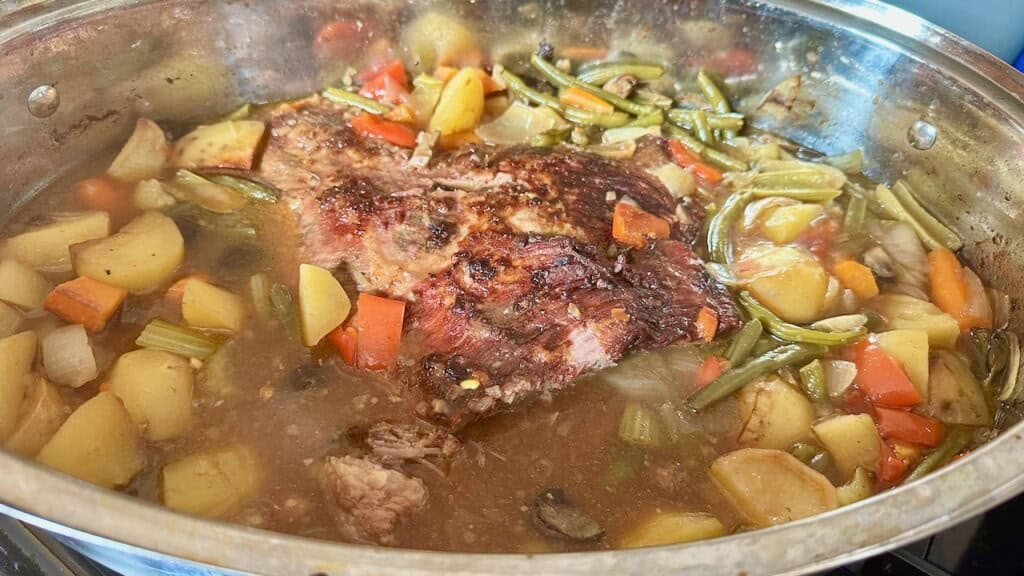
Have you ever wondered about the origin of this beloved dish?
The Early Beginnings
Brisket, often associated with Ashkenazi Jewish cuisine, has roots that can be traced back to Eastern Europe. In the 17th and 18th centuries, Jews living in Eastern Europe, particularly in regions that are now part of Poland and Ukraine, began cooking with inexpensive cuts of meat. Brisket, a flavorful yet tough cut of beef, was the perfect candidate and quickly became a family fave.
Jewish housewives of that era ingeniously developed techniques to tenderize and flavor the brisket. Slow-cooking the meat, often in a hearty and aromatic broth, became the key method for turning this tough cut into a mouthwatering delicacy. The combination of slow cooking and flavorful spices allowed the brisket to become a star of Jewish cuisine. My father’s recipe graced our table many times, but I didn’t appreciate it until I became an adult myself.
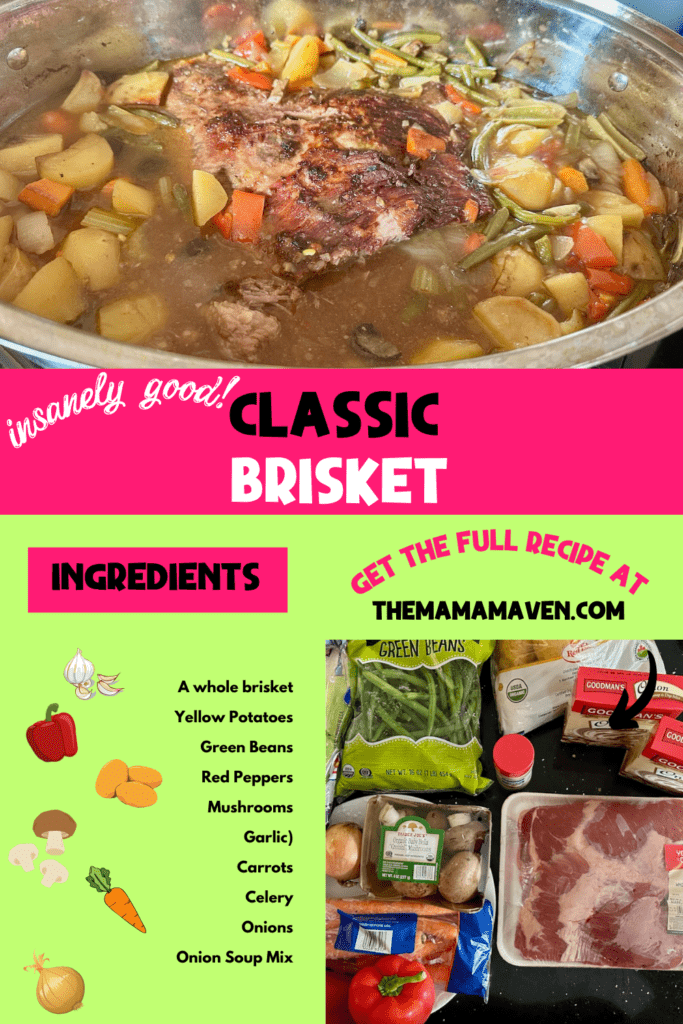
The Role of Brisket in Jewish Traditions
Over time, brisket earned its place in Jewish traditions and holidays. While it’s a popular dish year-round, it has a special significance during certain celebrations.
1. Passover: During Passover, when leavened bread is forbidden, brisket often takes center stage as a symbol of abundance. Its tender, savory goodness is a reminder of the joy of the holiday.
2. Rosh Hashanah and Yom Kippur: These High Holidays also feature brisket as a common dish, symbolizing the hope for a year filled with blessings.
3. Sabbath: Brisket frequently graces the Shabbat table, signifying the importance of a warm and hearty meal shared with loved ones.
4. Celebrations and Family Gatherings: Whether it’s a wedding, a Bar or Bat Mitzvah, or a simple family dinner, brisket has become a go-to choice for any joyful gathering.
Brisket’s Global Journey
As Jewish communities migrated to various parts of the world, the love for brisket traveled with them. In the United States, Jewish immigrants brought their cherished recipes, helping to establish brisket as a comfort food. Over time, it became a beloved American classic, enjoyed by people of all backgrounds.
Variations and Regional Twists
Brisket is a versatile dish that has evolved in different ways based on the region and the family’s preferences. Some families use tomato-based sauces, while others opt for a sweet and sour flavor profile. Various spices and seasonings are used to give brisket its unique character, and everyone has their favorite way of preparing it.
The Timeless Appeal of Jewish Brisket
Today, Jewish brisket continues to be a cherished culinary tradition. The simplicity of its preparation, the heartwarming flavors, and the way it brings families together have ensured its enduring popularity. With each bite, we connect with generations past, and we honor the culinary ingenuity of Jewish ancestors who turned a tough cut of meat into a delectable masterpiece.
In conclusion, Jewish brisket is more than just a dish; it’s a testament to the enduring nature of tradition and the way food can bind generations and cultures together. Whether you’re savoring a slice at a holiday meal or trying a family recipe passed down through the ages, Jewish brisket is a flavorful reminder of the richness of Jewish culinary heritage. Enjoy making this classic brisket recipe in your home and let me know how it turns out!
You’ll Need:
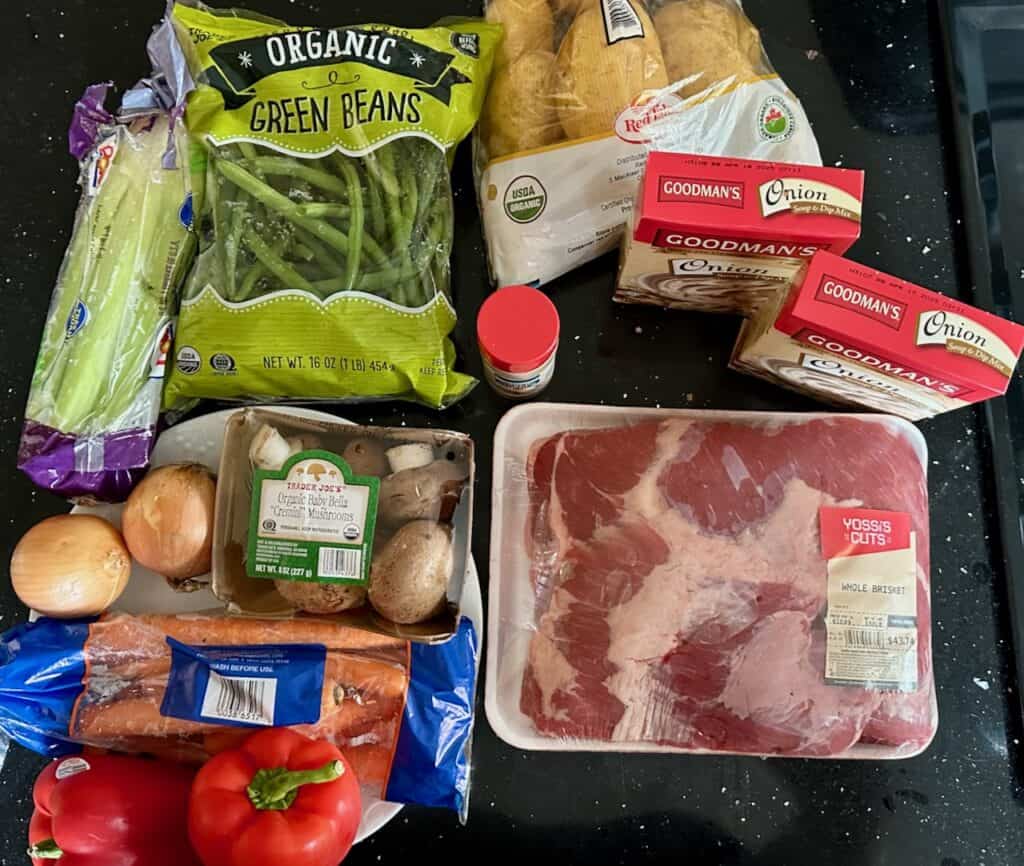
A whole brisket (expect to pay around $43-$55 for this – it’s around $7.99 a pound unless you can find it on sale)
Yellow Potatoes
Green Beans (fresh)
Red Pepper (1 or 2)
Mushrooms (optional)
Garlic (fresh cloves are better, but crushed or powder is fine)
Carrots
Celery
Onions
Onion Soup Mix – I like this one or this one
Substitutions:
If you don’t like yellow potatoes, you can use any kind you prefer.
I used a Kosher cut of brisket because I was near a Kosher supermarket and I knew they would have it in stock. It was more expensive at my local supermarket, $55, but only $43 at the Kosher supermarket. If you can snag one on sale and freeze it, that is the best way.
Instructions
Heat oven to 350 degrees Fahrenheit. Cut up the veggies.
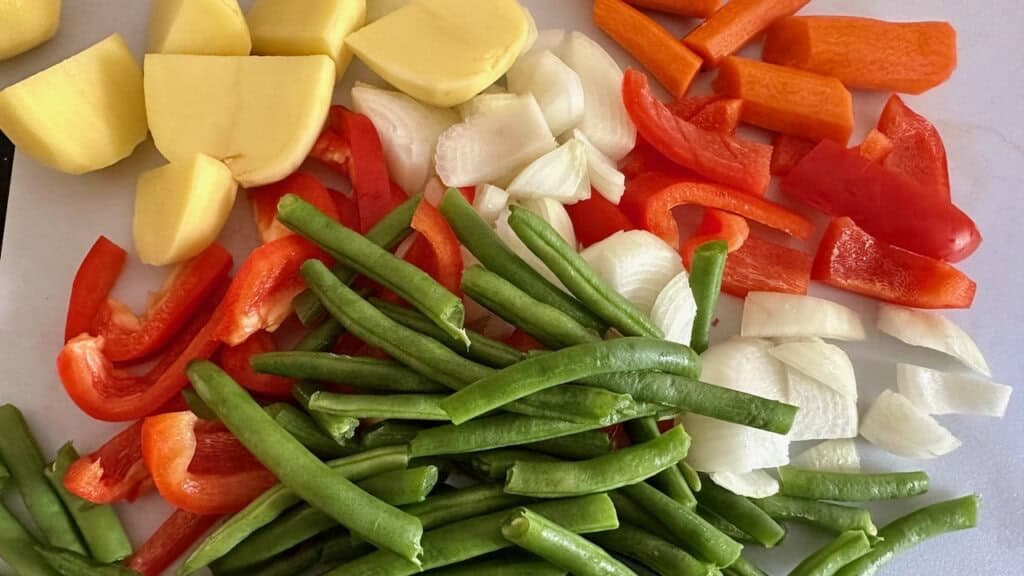
Place the brisket and vegetables in a roasting pan. Mix the onion soup packets with water and pour in until the brisket and vegetables are covered with liquid, adding more water as necessary. Cover and place in oven.
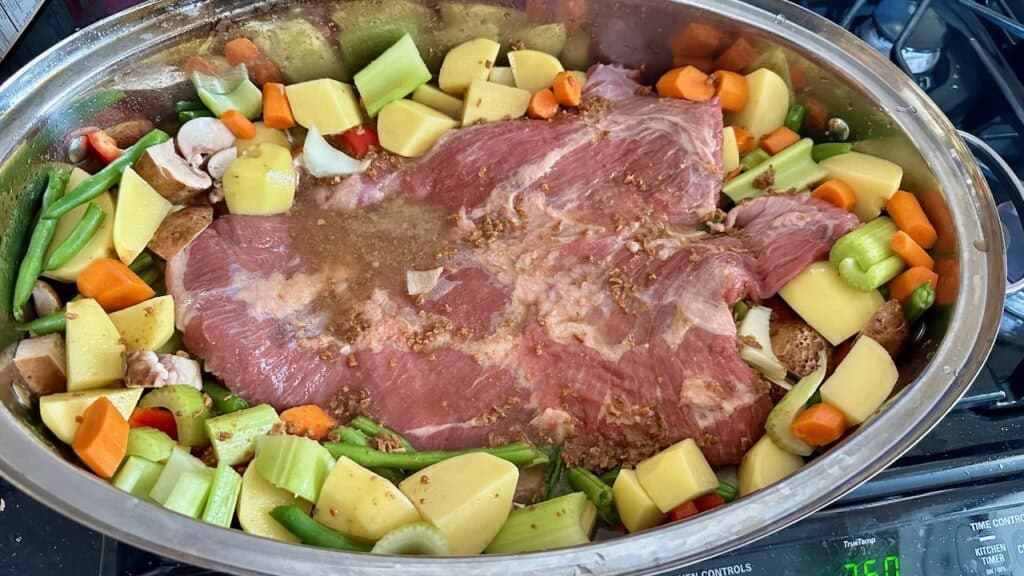
Cook covered for 2-3 hours until tender. I try to check on it and make sure the meat stays tender. Once it’s done, let it sit for 1 hour to rest. Serve.

Note: Some recipes use a tomato product such as ketchup or tomato paste, but my father’s does not.
Products Used
Onion Soup Mix
Roasting Pan – this one would work or this one
This post contains affiliate links from certain websites and Amazon. I receive payments for clicks, purchases, and/or registrations made through affiliate links in this post. Please see our disclosure policy for more information.
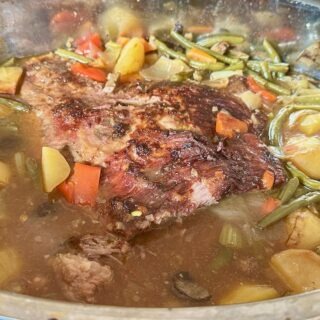
Classic Brisket
Equipment
- 1 Roasting Pan
Ingredients
- A whole brisket expect to pay around $43-$55 for this – it’s around $7.99 a pound unless you can find it on sale
- Yellow Potatoes
- Green Beans fresh
- Red Pepper 1 or 2
- Mushrooms optional
- Garlic fresh cloves are better, but crushed or powder is fine
- Carrots
- Celery
- Onions
- Onion Soup Mix I like this one or this one
Instructions
- Heat oven to 350 degrees Fahrenheit. Cut up the veggies.
- Place the brisket and vegetables in a roasting pan. Mix the onion soup packets with water and pour in until the brisket and vegetables are covered with liquid, adding more water as necessary. Cover and place in oven.
- Cook covered for 2-3 hours until tender. I try to check on it and make sure the meat stays tender. Once it’s done, let it sit for 1 hour to rest. Serve.
Notes
I used a Kosher cut of brisket because I was near a Kosher supermarket and I knew they would have it in stock. It was more expensive at my local supermarket, $55, but only $43 at the Kosher supermarket. If you can snag one on sale and freeze it, that is the best way.





[…] Classic Brisket […]